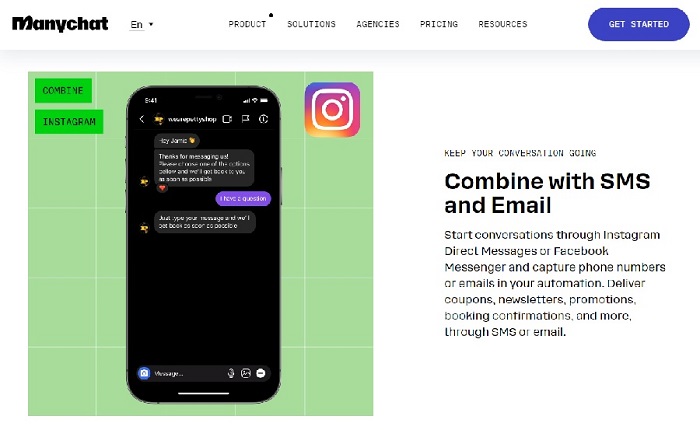How to start an e-commerce: 12 Essential Steps in 2023
E-commerce has been around for nearly 30 years, but this business model has exploded in popularity since the COVID-19 pandemic. To get an idea of this growth, in 2020 alone the sector earned around $800 billion, representing an increase of around 34% compared to 2019. If you’re in doubt of how to start an e-commerce and how to sell online, know that while not difficult, you should follow certain steps to be successful with your business.
Some of the important points in the process of opening an online store are:
- Choose a name and logo for your brand;
- Register the domain;
- Choose one of the sales website platforms;
- Add a payment system.
However, there are many other important steps you will need to take to get your business online. Keep reading to learn the 12 steps on how to start an e-commerce and earn money with your online business!
How much does it cost to start an online store?
According to a survey carried out in 2023, the initial investment needed to start an e-commerce is at least $1,000. However, this value may vary depending on the business model, the chosen e-commerce platform, development costs, inventory, etc, and it can reach $100,000 for large-scale companies.
Also, keep in mind that you will need to invest in a good online chat program and one of the customer support tools for your business. We have already tested some here on AppTuts, and we can recommend:
With that said, it’s time for you to know step by step how to start an e-commerce.
12 steps to start an e-commerce
1. Create a complete business plan
Without a doubt, this is the most important step. After all, there’s no point in having the best designers and a good platform for your e-commerce if you don’t have a well-defined and complete business plan. Therefore, define your niche, choosing a segment in which you have not only knowledge but also interest.
After that, you need to know who your target audience is. With the niche defined, research which people are interested in it. For example, if your e-commerce focuses on technology products, it may be much more attractive to Millennials and Generation Z. On the other hand, Baby Boomers and Generation X may be more attracted to products related to travel and lifestyle.
By understanding your audience well, you will be able to offer products or services that really meet their expectations, within your business model. Speaking of a business model, don’t forget to be clear about the standard you will adopt. Whether selling your own products or reselling third-party products, subscriptions, or dropshipping, you need to be clear about the advantages and implementations of each model.
Still talking about your business planning, research the types of companies that exist and which one is ideal for your profile. A sole proprietorship or limited partnership operates under different laws and taxation. Since all of this affects not only how you function but also your budget, it’s worth taking the time to understand how each category works.
2. Organize your budget
Continuing with our list of steps on how to start e-commerce, we need to talk about the budget. As mentioned, the cost to start an e-commerce can vary. However, this does not prevent you from organizing yourself financially and having a defined budget. Have a clear and realistic view of the money you have available to start your business, without having to take it from other areas necessary for your well-being.
Before starting the other steps, have a financial plan, as the first steps will only be investments without any profit. For this reason, establish a maximum amount that you can initially make available to your e-commerce. This will certainly help you not to overspend.
Speaking of expenses, see, throughout this article, which ones will be essential for the basic operation of your e-commerce and which will help you convert customers. You will also need to have working capital for your recurring expenses and also have some savings for unforeseen events that may occur so that your e-commerce is protected from setbacks.
Finally, be sure to always check your budget. With your business online, cash flow can change, and tracking your spending and income will help you make the best resource allocations when needed.
3. Think of a name and logo for your brand
Next up in our step-by-step guide on how to start an e-commerce website, there is another part that deserves close attention: choosing the name and logo for your brand. They will be your customer’s first impression and surely you have heard the famous saying that the first impression is the last impression.
As such, the name and logo need to carry the weight of your brand, conveying its true essence, but it must also be catchy and easy to remember. Try to make a choice that is related to your niche and that is associated with the product offered.
Short, easy-to-pronounce names should be at the top of your list. Numbers, hyphens, or special characters can also be an excellent choice to cause that catchy feeling in your customer’s mind.
But no skimping on research, eh? After all, your brand name and logo need to be original. Imagine being mistaken for an existing company and causing confusion in your customers’ minds. Or even be accused of plagiarism? None of this is good for your e-commerce image.
An extra tip is to do market research and choose a name that has words that arouse positive emotions in consumers. That way, they will be able to quickly remember your brand or make associations with it in common everyday moments. Remember: your business name is also a form of marketing and needs to be taken seriously.
4. Register the domain
With a defined name, to start an e-commerce you need to register a domain, as it is the first step in establishing your online presence. Simply put, a domain is the virtual address of your website, like www.apptuts.net. It is through it that your customers will be able to access your virtual store. Therefore, you need to consider some important things when starting this process.
Check if the chosen name, made in the previous step, is available to be registered. In this sense, we consider that domain registration and the choice of brand name must go hand in hand in the creation of your e-commerce. Among the companies where you can register and check the availability of the chosen name, we can mention Hostinger, GoDaddy, and HostGator.
If the name is unavailable, you’ll need to consider other alternatives for naming your brand, or you could check to see if the domain can be purchased from the current owner. If you choose the second option, see if it’s really worth it, as this purchase can be very expensive, increasing your initial expenses in starting your e-commerce.
You will also need to choose a domain extension that is relevant to your country. The most common extensions worldwide are .com or .net, for instance, and they can be an excellent choice. However, depending on your country, you might want to use an extension that reflects the country, such as .ca for Canada. After that, just register your brand and take the first step in starting your e-commerce.
5. Choose an e-commerce platform
Moving forward with our list of steps on how to start an e-commerce, the other very important choice in your process of creating e-commerce is the right e-commerce platform. This step deserves a lot of attention, as it will be where your products and services will be displayed to your customers. There are several e-commerce platform options available, such as Shopify, BigCommerce, and PrestaShop.
We know that the price of each one of them is an important point to be analyzed, but it shouldn’t be your only concern. Once you have properly defined the products and services you will offer, the necessary resources, and the size of your store, see which platform best suits those needs and your budget.
Don’t forget to check out the scalability the company offers. You are creating a business to grow and not be paralyzed in time, and the chosen platform needs to support and not limit your growth. Of course, to grow, you need an environment that is simple and intuitive to work with. So, see if the platform you choose will give you an easy structure for adding products and managing orders.
Further, analyze how the company’s customer support works. Fast service is necessary for this online environment, especially when you are selling and need some support from the platform. A plus that the chosen platform can also offer is some marketing resources, such as integration with social networks, to facilitate the dissemination of your service.
6. Find reliable suppliers with good prices
To start an e-commerce, the perfect balance in this step is to find quality products at competitive prices. That way, both you and your customers will be satisfied. But how do you find suppliers that fit these criteria?
The first step is to Google the main suppliers that are related to your niche and search social networks and TrustPilot for their reputation with customers. In addition, you can participate in fairs and trade events related to your sector. These moments can be ideal to meet potential business partners, evaluate the product up close, and maybe get a nice discount on your first purchase.
If you don’t have the opportunity to attend events, you can request samples from the companies you research. As a result, you will be able to evaluate the product and see if it has the quality you want to deliver, in addition to comparing the cost-effectiveness with different suppliers. This can even help you negotiate better prices and conditions.
As unforeseen events can happen and, in some cases, products can be sent with a lower quality than expected, before closing a deal with a supplier, review their return policies. Very long deadlines to return a damaged product, for example, can cause enormous dissatisfaction for your customer and perhaps lead them to give up the purchase.
7. Set up your virtual store and register the products
Now it’s time to turn your idea into a reality, and this is one of the most exciting parts of starting an e-commerce business. When setting up your virtual store, you should think of a layout that speaks to your niche to generate a good browsing experience for the user. Therefore, choose a theme or design that reflects your brand’s visual identity and use colors, fonts, and other visual elements to create a unique place to shop online.
But don’t just focus on aesthetics. Your website needs to be straightforward and clear so that it doesn’t become confusing for your target audience. The steps for the customer to place an order need to be easy to see and understand. After all, your goal is to get people to buy from you. Therefore, the search bar and filtering must be highlighted.
Another ally of the look of your site is the products you will add. Be careful with the photos and descriptions, not forgetting to include relevant information. For example, if your e-commerce is for clothing, characteristics such as color, size, and material must be highlighted.
Also, you can organize your products into categories so they can be found faster. Remember that a virtual store does not have a face-to-face service. Therefore, every detail matters so that your customer buys the product offered by you without a doubt that it will meet their expectations.
8. Choose a payment system
In our guide on how to create e-commerce, we cannot fail to highlight the importance of carefully choosing the payment systems that will be used. Among the options you can consider for receiving money from your customers are: payment intermediary, gateway, and direct integration.
The payment intermediary is usually ideal for small and medium-sized businesses. In this model, a third-party company acts as an intermediary between the seller and the buyer. That is, it receives the customer’s money and transfers it to you for a small fee.
The payment gateway, which is aimed at virtual stores and large companies, allows direct connection between electronic commerce and financial institutions. In this way, it is directly integrated into your work system, and the customer chooses the card and enters their info.
Direct integration, although an option, may not be ideal for those starting out in this universe. This is because it requires a greater financial investment, as it involves creating a customized solution to receive payments. In addition, you would also need to have prior knowledge to carry out the onboarding process and would be responsible for risk management.
Don’t forget to also carry out a survey to find out which are the safest payment methods used by consumers of online products. Make the customer’s experience as easy as possible at the time of payment, so that they can buy both via credit or debit card, digital wallets, and even cryptocurrencies, which may be an option.
9. Find good shipping options
One of the great benefits of buying online is that the product arrives directly at our doorstep, and that’s what your customer will expect when buying from you. Even better if in this experience the shipping is fast. After all, it is very unpleasant to buy a product and have to wait 15 days or more for it to arrive, especially if it is delivered directly from your own country.
Work with carriers that have a reputation for delivering orders on time and offering a fair price. Cheap shipping can also be a great advantage for your product. One piece of information you need to know is that the shipping cost is the second item that directly influences the purchase decision. It is so important that it is second only to the value of the product.
Companies like UPS, USPS, and FedEx are some of the most used by e-commerces. However, some companies are already innovating and, in sales carried out in the same neighborhood or city, they use Uber Flash to make deliveries faster. Therefore, study this area well and see what best suits your business. To make things easier, use one of these tools to calculate shipping.
You can also have reliable logistics partners that offer fast delivery and order tracking. This can be another strong point of your virtual store. And of course, have different shipping options like express and economy delivery. If your e-commerce is an extension of your physical business, also offer the option of picking up at the store, so that the customer can have faster access to the product if they prefer.
10. Invest in online store security
In addition to quality products and a fair price, you need to ensure that your customer has a safe shopping experience with you. For this reason, your online store must guarantee the safety of people who will buy from you and protect your consumers’ personal data. But not only that, your company information also needs to be protected.
With consumers becoming more aware of the need for protection in the digital world, the first step you should take is to purchase an SSL certificate. You need it for credit card payments and also to protect the data that is transmitted between your e-commerce and your customer’s browser.
Another important task is to keep all the plugins you use up to date. Overall, developers work on updates to fix potential vulnerabilities. A practice that should also be adopted in the administrative accounts of your virtual store is two-factor authentication, or simply 2FA. Thus, you prevent unauthorized persons from accessing confidential information.
By the way, also try to understand the anti-fraud tools available on the market. They can help you to prevent fraudulent activities by analyzing patterns of behavior or even identifying suspicious transactions. ClearSale, FraudLabs Pro, and CyberSource are some of the most trusted.
11. Plan what customer service will be like
It’s not because your business is online only that customer service should be neglected. The way a customer is treated is very important to the success of your store. The service you offer can result in positive or negative organic marketing, everything will depend on how you will offer it. For this reason, provide several forms of contact for the customer to answer questions.
Although email contact is important, it should not be the only one adopted by your e-commerce. Have a chat for faster and more direct contacts, offer the option of service through messengers such as WhatsApp or Telegram, and even make your company’s social networks available for this functionality. Always remember that each person has a different profile and preferred contact platforms.
But it’s also no use offering all these forms of contact and not responding to your customer. Have bots or use artificial intelligence platforms so that some services are carried out more quickly, but in the case of something more specific, have a person or team responsible for this function.
In this sense, to increase the efficiency of customer service in your e-commerce, you can use a chat and chatbot automation tool. Here at AppTuts, we’ve already tested and can recommend these:
Further, having an FAQ on your website is very important for your customer relationship. In it, you can leave clear information about the main questions, such as delivery times, return and exchange policies, warranty terms, and fees.
12. Apply marketing strategies
Finishing our selection of steps on how to start an e-commerce, marketing and SEO strategies can be useful to improve the visibility of your e-commerce. See what your competition is doing, and what keywords they are using, and see how to adapt the content for you in an original way. Make use of social media to create relevant content, as well.
You can even offer exclusive offers to your social media followers to help with engagement. However, be careful with the promotions you intend to carry out. Don’t do it all the time, as your customers might get used to buying only when you offer a discount. Paying for boosting ads with creatives about your product can also help drive sales.
Lastly, don’t be shy about asking your customers for testimonials. Positive reviews can help you build more authority for your product and are an excellent form of marketing. But no picking up fake testimonials. They are easily discovered and can tarnish your company’s reputation.
What does it take to set up an e-commerce?
Setting up an e-commerce site involves several steps, but some are quite basic, such as choosing a name and logo for your brand, registering your domain, choosing a payment system, choosing an e-commerce platform, and finding reliable suppliers at good prices.
How much do I need to start an e-commerce?
The cost of starting an e-commerce can vary greatly. In some cases, especially when it comes to a small store that does not have its own stock, a thousand dollars may be enough. However, depending on the e-commerce platform chosen, development and stock costs can drive this up to over 10 thousand dollars.
How to start an e-commerce with little money?
To start an online store on a low budget, first look for a free or cheaper online store solution. You can start selling products in dropshipping format, where you don’t have to worry about stock. Finally, don’t use the paid boost service and advertise your store yourself on social media.
What else sells in a virtual store?
The best-selling product categories in virtual stores are clothing and accessories, electronics and home appliances, beauty and personal care products, home and garden items, toys, and games, in addition to books (printed or ebooks) and fully digital, such as courses and training.
What kind of online store makes money?
Any kind of online store can make money if it’s managed well. However, to be profitable, your products need to be in demand, that is, interested buyers. Clothing stores tend to be very popular. Likewise, beauty and personal care stores are also highly sought after.
Did you learn how to start an e-commerce?
We have reached the end of our step-by-step guide on how to start an e-commerce. By following all the tips above, you will have everything perfect to start promoting your e-commerce marketing strategies. Your target audience was defined at the beginning and now it’s time to use their language, behavior, and preferences in your favor to have a successful disclosure campaign.










